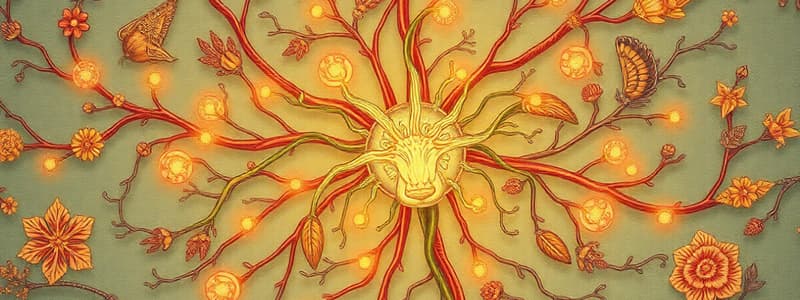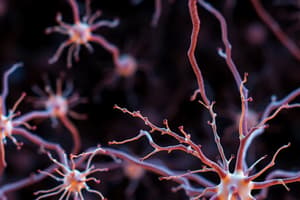Podcast
Questions and Answers
What does studying the nervous system help us understand about sensory functions?
What does studying the nervous system help us understand about sensory functions?
- The physical location of emotions in the brain.
- How sensory information aids in perception. (correct)
- The genetic structure of nerve cells.
- The role of muscular movement in behavior.
Which approach focuses primarily on how bodily disorders affect behavior?
Which approach focuses primarily on how bodily disorders affect behavior?
- Clinical approach (correct)
- Philosophical approach
- Cognitive approach
- Experimental approach
What is the primary function of the nerve cell body?
What is the primary function of the nerve cell body?
- To store genetic information without controlling activities.
- To integrate sensory information and control metabolic activities. (correct)
- To conduct impulses away from the cell.
- To form the myelin sheath around the axon.
What are Schwann cells responsible for?
What are Schwann cells responsible for?
What is the primary purpose of the myelin sheath?
What is the primary purpose of the myelin sheath?
Which statement is true regarding the axon?
Which statement is true regarding the axon?
What does the neuron doctrine state about the brain?
What does the neuron doctrine state about the brain?
What type of information does the nervous system primarily transmit?
What type of information does the nervous system primarily transmit?
What is the function of the sensory nuclei in the thalamus?
What is the function of the sensory nuclei in the thalamus?
Which nuclei in the thalamus are responsible for processing auditory signals?
Which nuclei in the thalamus are responsible for processing auditory signals?
What structure is formed by the mass intermedia in the thalamus?
What structure is formed by the mass intermedia in the thalamus?
Which part of the brain is primarily involved in regulating motivated behaviors?
Which part of the brain is primarily involved in regulating motivated behaviors?
What do the longitudinal fissure and the corpus callosum have in common?
What do the longitudinal fissure and the corpus callosum have in common?
Which type of cortical neuron is characterized by a pyramid-shaped cell body?
Which type of cortical neuron is characterized by a pyramid-shaped cell body?
What is the primary role of the precentral gyrus in the cerebral cortex?
What is the primary role of the precentral gyrus in the cerebral cortex?
How do convolution patterns like gyri and sulci benefit the cerebral cortex?
How do convolution patterns like gyri and sulci benefit the cerebral cortex?
What is the primary function of axonal transport?
What is the primary function of axonal transport?
What characterizes a multipolar neuron?
What characterizes a multipolar neuron?
Which type of glial cell is known for removing cellular debris?
Which type of glial cell is known for removing cellular debris?
What is the role of neurotransmitters in the synapse?
What is the role of neurotransmitters in the synapse?
Which statement best describes oligodendrocytes?
Which statement best describes oligodendrocytes?
What differentiates unipolar neurons from bipolar neurons?
What differentiates unipolar neurons from bipolar neurons?
Which of the following is a function of glial cells?
Which of the following is a function of glial cells?
What is the synaptic cleft?
What is the synaptic cleft?
What is a primary characteristic of layer IV in the neocortex?
What is a primary characteristic of layer IV in the neocortex?
Which part of the brain is primarily responsible for memory formation?
Which part of the brain is primarily responsible for memory formation?
What does the corpus callosum connect?
What does the corpus callosum connect?
What is the primary function of the occipital lobe?
What is the primary function of the occipital lobe?
Which lobe of the brain is primarily responsible for evaluating taste and temperature sensations?
Which lobe of the brain is primarily responsible for evaluating taste and temperature sensations?
What structural feature allows the corpus callosum to fit within the skull?
What structural feature allows the corpus callosum to fit within the skull?
What characteristic distinguishes layer V of the neocortex?
What characteristic distinguishes layer V of the neocortex?
Which lobe is involved in abstract thought and judgment decisions?
Which lobe is involved in abstract thought and judgment decisions?
What occurs when an action potential reaches the axon terminal of a neuron?
What occurs when an action potential reaches the axon terminal of a neuron?
Which part of the brain is primarily responsible for vital activities such as breathing and heartbeat regulation?
Which part of the brain is primarily responsible for vital activities such as breathing and heartbeat regulation?
What role does the reticular formation play in the brain?
What role does the reticular formation play in the brain?
Where is the cerebellum located?
Where is the cerebellum located?
What triggers the influx of sodium ions into the post synaptic cell?
What triggers the influx of sodium ions into the post synaptic cell?
Which structure in the midbrain is responsible for auditory function?
Which structure in the midbrain is responsible for auditory function?
What is primarily housed within the metencephalon?
What is primarily housed within the metencephalon?
How are neurotransmitters managed after they have attached to receptor sites?
How are neurotransmitters managed after they have attached to receptor sites?
Flashcards are hidden until you start studying
Study Notes
Importance of Studying the Nervous System
- Understanding sensory functions enhances perception.
- Neural activity correlates with movement and coordination.
- Reveals the relationship between internal states, emotions, and drives.
- Provides insight into brain cell functions in learning and memory.
- Practical implications for maladjustment and behavioral disorders.
Key Questions About the Human Brain
- How does the brain maintain and repair itself, and how does this relate to behavior?
- How does the brain process and utilize environmental information?
- How does the brain regulate motivated behaviors such as hunger, sleep, and emotional responses?
- How does the brain store and retrieve information?
Methods and Approaches
- Philosophical view: Mental states arise from bodily states (e.g., Hippocrates).
- Clinical approach: Focuses on bodily disorders impacting behavior and mental activity.
- Experimental approach: Involves hypothesis formulation and deduction; prevalent in Biological and Physiological Psychology.
Microscopic View of the Nervous System
- Neuron Doctrine: Brain consists of distinct cells separate in structure, metabolism, and function (Ramon Cajal).
- Nervous System: Transmits, integrates, and discriminates sensory information.
Parts of the Nerve Cell
- Nerve Cell Body: Contains the nucleus and controls metabolic activities; integrates sensory information.
- Axon: Conducts impulses away from the cell body; enhanced by myelin sheath for quicker transmission.
- Dendrites: Branch-like extensions that receive signals from other neurons.
- Synapse: Junction where neurotransmission occurs, involving presynaptic and postsynaptic cells.
Types of Nerve Cells
- Multipolar Neuron: Many dendrites and a single axon (e.g., cortical pyramidal cells).
- Bipolar Neuron: One dendrite and one axon.
- Unipolar Neuron: A single branch extending in two directions (e.g., invertebrate nervous systems).
- Size varieties: small (granular, spindle, stellate) and large (pyramidal, Golgi type, Purkinje cells).
Glial Cells
- Most abundant cells in the brain.
- Functions: Provide structural support, pathway for nutrients, and produce myelin sheath.
- Types:
- Astrocyte: Star-shaped, numerous extensions.
- Oligodendrocyte: Smaller with fewer processes.
- Microglia: Small, activated during disease to remove debris.
Synaptic Transmission
- Neurotransmitters are synthesized in the presynaptic neuron and stored in vesicles.
- Action potentials trigger release into the synapse, affecting postsynaptic receptors.
- Neurotransmitters can be recycled or broken down by enzymes.
Central Nervous System
- Myelencephalon (Medulla): Controls vital functions like heart rate and breathing; houses the reticular formation for sleep and attention.
- Metencephalon: Contains ascending and descending tracts; includes the pons and cerebellum for balance and sensory functions.
- Mesencephalon (Midbrain): Composed of tectum and tegmentum, involved in auditory and visual processing.
Diencephalon
- Thalamus: Processes sensory signals and transmits them to the sensory cortex; comprises lateral, medial, and ventral posterior nuclei.
- Hypothalamus: Regulates motivated behaviors and hormone release from the pituitary gland; includes optic chiasm and mammillary bodies.
Telencephalon
- Cerebral Cortex: Convoluted to increase surface area; divided into fissures, sulci, and gyri.
- Lobes of the Brain:
- Frontal Lobe: Controls voluntary muscles, mood, and aggression.
- Parietal Lobe: Processes sensory information of touch and temperature.
- Temporal Lobe: Evaluates auditory and olfactory information, involved in memory.
- Occipital Lobe: Responsible for visual input processing.
- Neocortex: Six-layered structure with pyramidal and stellate cells; exhibits columnar organization.
Hippocampus
- Located in the medial temporal lobe; crucial for memory formation.
Corpus Callosum
- Connects the two cerebral hemispheres with a unique pattern of folds.
Summary of Functions
- Sensory Projection Area: Where sensory messages are registered.
- Motor Projection Area: Initiates responses and commands to muscles and glands.
Studying That Suits You
Use AI to generate personalized quizzes and flashcards to suit your learning preferences.




